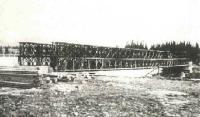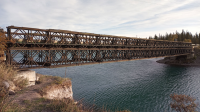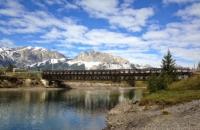In October 1950, a significant engineering challenge arose at the Canada Cement plant in Exshaw, Alberta. A steel truss bridge spanning the Kananaskis River had collapsed, severing vital access to a slate pit that was essential for the plant's operations. Recognizing the urgency of the situation, the plant's General Manager—a former commander of a wartime Royal Canadian Engineer field company—sought assistance from Major Jack Yeats and the 13th Field Squadron RCE to erect a Bailey Bridge.
The Bailey Bridge was designed by Donald Bailey in 1936 and became widely recognized during World War II for its rapid deployment capabilities. Constructed from lightweight steel panels and cross-braced structures, Bailey bridges could support substantial loads while remaining easily transportable. Its modular design allowed for quick assembly, making it ideal for both military and civilian applications.
In November 1950, arrangements were made to deliver bridge components from Ontario Hydro's surplus Baily Bridge stocks. Canada Cement prepared for the bridge's construction by building bankseats to support it. A skeleton crew of trained sappers from the 13th Field Squadron supervised a work party composed of company employees and militia members. Working late into the night using vehicle headlights, they successfully erected a 160-foot Triple-Double Bailey Bridge – a remarkable achievement. They believed to be the first private bridge constructed in Canada after World War II.
The construction of the Kananaskis River Bridge not only restored vital access to the slate pit but also showcased the adaptability of Bailey Bridge technology. Over the years, as trucks grew larger, modifications became necessary to accommodate these vehicles. In an unusual construction sequence, workers raised the entire deck five feet from its original position without dismantling it—a testament to the flexibility inherent in Bailey designs.
As one of Canada's longest-standing private Bailey bridges, this structure has endured decades of use and adaptation. Its continued operation highlights the durability and effectiveness of Bailey's design philosophy, which has been emulated worldwide. Many original Bailey bridges remain functional today, demonstrating their robust construction and adaptability.
Many of the Bailey Bridges in permanent use in Canada can be seen HERE.


